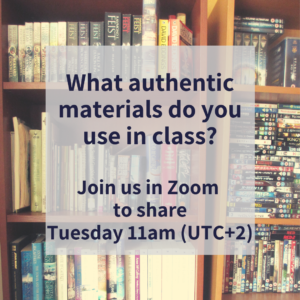We had a smaller group today so stayed in the main room for the whole chat. The original questions around the topic were:
- What authentic materials do you use in class?
- Where do you find them? How do you use them?
- What do we need to consider when bringing authentic materials into the classroom?
These were some of the sites and ideas mentioned for where we can find materials to use in class.
- ESL Brains on Facebook
- onestopenglish
- BBC Reel
- TED talks
- 60 second docs
- National Geographic
- Fiction Express
For ESP / Business English, company websites were mentioned as a resource to use as this will give you topic-based vocabulary which your learners need. It can also be trickier to source materials for ESP – for example, research papers written in English on a topic may only be available through a paid subscription site; in other cases the material may be redacted if it includes sensitive information.
In terms of working with reading materials, there were also suggestions of using readers, short stories (such as Roald Dahl) and making the most of video transcripts from authentic sources, such as TED. Some teachers mentioned doing an extensive reading project with higher-level groups and using an original text to find idiomatic language.
We touched again on an issue which has come up before, that learners don’t have the patience to work with longer texts and that teens seem to be reading less in general. Fiction Express is trying to make reading a more interactive process and works in a ‘build your own adventure’ format – a chapter is published each week and readers vote on what will happen next.
There was also some chat around reading as part of the class – though it’s something many of us did pre-Covid, it somehow feels like the time online should be used more efficiently than asking learners to read a lengthy text and do some comprehension activities around it.
Another aspect we discussed was finding resources which were age- and/or level-appropriate. There was consensus that what some of our teen and younger learners are seeing outside the classroom isn’t necessarily what we would feel comfortable working with as a resource in a lesson. We started off thinking about the sort of music videos our learners sometimes request but then also considered the idea of bringing ‘authentic issues’ into the classroom and how sensitivity is needed to ensure that we don’t trigger learners.
Related to this topic was the question of what ‘authentic’ really is – for example, BBC newsreaders will often use quite flat intonation, have very limited or unclear body language and no false starts. This idea that if learners learnt English from one particular media – such as the news – then they would have a very one-sided view of the language was mentioned at some point (possibly by David Crystal?) but I can’t find a link to a quote now!
We also talked about how to exploit materials in the best way – one suggestion was to look for videos which are linked to common coursebook topics as then you’ll be more likely to be able to rewatch it with a different group. We also chatted briefly about using the same material with different levels – you could have a ‘complex’ video with a very simple task for a lower-level group and watch the same video with a more challenging task for higher levels. Another idea was watching videos with the sound off to focus and asking learners to look for certain things or to imagine what the conversation is, etc.
One issue which came up frequently was time – the time to find a material and plan a lesson around it which you can make the most of. There were also comments that working in a context without a coursebook gives you much more freedom to find your own materials for a class, but conversely you don’t have the security of a coursebook when you need to plan a lesson quickly.
